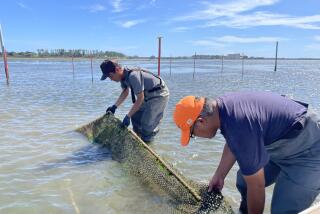Outdoor Notes : Greenpeace Urges End of Gill Nets
- Share via
Calling gill nets “curtains of death,” Greenpeace is campaigning with international commercial fishing organizations to urge Japan, Taiwan and South Korea to phase out their use of the nets in the North Pacific.
Gill nets are monofilament-webbed nets, hung vertically in the ocean with floats at the top and weights at the bottom. The nets trap and kill any marine animal, fish or bird that becomes entangled. In a news package sent to media outlets across the United States, Greenpeace makes the following claims about gill nets in the North Pacific:
--Gill nets are the largest cause of marine mammal death in the North Pacific today, citing a National Marine Fisheries Service estimate that Japan’s salmon drift net fleets alone incidentally kill about 5,000 Dall’s porpoises per year.
--Japanese, Taiwan and South Korean gill nets kill hundreds of thousands of sea birds and lesser numbers of turtles.
--Japanese gill nets are a factor in the decline of U.S. and Canadian salmon stocks, which are intercepted at sea by Japanese gill nets. Greenpeace adds: “Wasteful drift nets are estimated to lose one adult salmon for every three landed.”
--Japan, Taiwan and South Korea have a combined total of more than 700 ships that use drift nets to catch squid. In addition, Japan operates 381 gill net vessels that fish for salmon, including a 172-ship fleet in the Bering Sea.
--In the mid-Pacific, Japan and Taiwan operate more than 600 additional drift net vessels fishing for marlin, sailfish and other species. The two countries, during billfish seasons, set out over 20,000 miles of nets daily. --The squid and billfish fisheries are not regulated by any international fisheries agreement.
--Lost or abandoned gill nets, aimlessly adrift in the North Pacific, annually kill thousands of seals, cetaceans, sea birds, turtles and fish.
The Environmental Protection Agency says the pesticide tributyltin, used for the last 20 years in the manufacture of effective antifoulant paints for the bottoms of ship and boat hulls, is highly toxic and potentially lethal to marine and freshwater organisms. The EPA urges the use of copper-based antifoulant paints containing no tributyltin.
Recreational Boaters of California points out that two bills recently introduced in the State Legislature would toughen laws relating to intoxicated operators of boats. One would give a peace officer authority to arrest, without a warrant, a person involved in a boat accident when the officer has cause to believe the person had been operating the boat under the influence of alcohol or any other drug.
Briefly
Showtime: Western Fishing Tackle & Fishing Boat Show, Long Beach Convention Center, March 5-9. . . . Frank LoPreste, skipper of the San Diego-based long-range boat Royal Polaris, says a South Korean long-line commercial fishing boat in the Indian Ocean recently caught a 428-pound yellowfin tuna. Southland long-range tuna sport fishermen have been trying for years to break the 400-pound barrier. . . . Marina Del Rey Anglers will hold their halibut derby April 12-13. . . . Wyoming’s Game and Fish Department has been allocated $235,000 to build a black-footed ferret captive breeding facility near Cheyenne. . . . Carol Ann Heryford, 39, and Calvin Lee Heryford, 43, of Modoc County, after being cited twice in one year for violating bobcat trapping regulations, were ordered to pay fines totaling $750 recently in Susanville. . . . Californians interested in suggesting changes in the state’s mammal hunting and trapping regulations must do so with the Fish and Game Commission by March 7. . . . Bill Mason, noted Montana-Idaho fishing guide and outfitter, will speak Feb. 20 at the Sierra Pacific Flyfishers 6:30 p.m. dinner meeting at the Nob Hill Banquet Center, Panorama City. . . . Southern California Boat Show officials report that a single day record 11,700 visitors saw the show last Saturday at the Los Angeles Convention Center.
More to Read
Sign up for Essential California
The most important California stories and recommendations in your inbox every morning.
You may occasionally receive promotional content from the Los Angeles Times.










